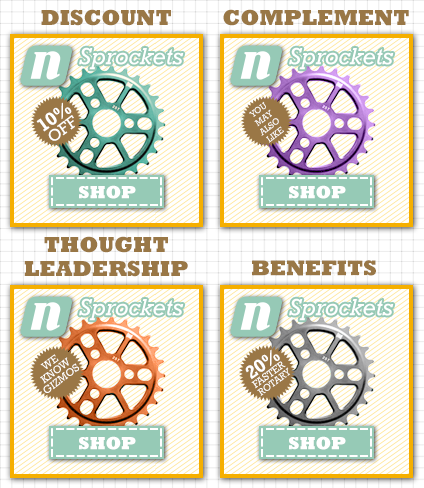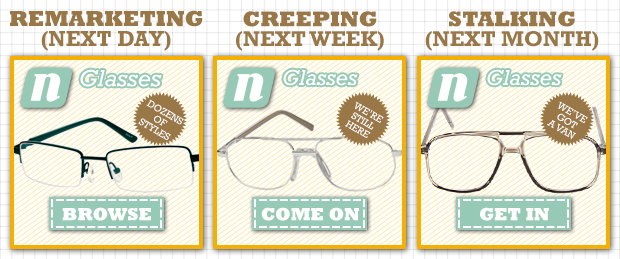Beyond Reach & Frequency: How To Do Retargeting Right

While versions of retargeting have been around for many years, it seems like 2012 was the year that everyone jumped on the retargeting bandwagon. Clients are clamoring for it and marketers all know it’s an essential component of a digital strategy.
Put simply, retargeting allows you to re-target your audience with custom ads based on their past history on your site or, in some cases, on other sites. So those ads you see that constantly show you the 5 products you just viewed on a site? Those are retargeting ads.
Retargeting has a lot of potential when done correctly.
Studies have shown that only 2-5% of people convert on their first visit to a site. So, retargeting, when done correctly, can be more powerful and effective than any of your other digital campaigns. The problem is that most people aren’t taking full advantage of their options or, even worse, are completely annoying their audience with their efforts. Luckily, this problem is easily solved with a little imagination and a lot of dedication.
Successful retargeting campaigns all do two things: they respect the user, and they provide real value to the audience at the right time.
This sounds easy enough in theory, but how do you put this into practice?
Your audience isn’t homogenous. Don’t treat them like they are.

Sure, your audience may have similarities, but showing the same ad to everyone, regardless of demographics or interactions with your site, is the single biggest retargeting mistake you can make.
Every retargeting platform gives you the opportunity to segment your audience. There are many ways to do this: if you have an ecommerce site, you may want to target shoppers based on what they’ve previously viewed; if you have a lead gen site, you may want to segment your audience by how far down the conversion funnel they went.
Specific demographic targeting can be more difficult to accomplish depending on your retargeting platform. Google doesn’t offer the option to retarget by specific demographic, but if you want to get really fancy, you can get around this by using Facebook ads.
For example, if you created a Facebook ad that targeted women ages 24–34 with a college degree and used a specific landing page for those ads, you could also set a retargeting cookie on that landing page, essentially giving you a specific demographic pool to then retarget to!
You can even target visitors who actually did convert. If you are in an industry that encourages repeat purchasers, it makes sense to create ads that target segments of users who already bought something. If you are a lead gen site with a longer sales cycle, you can create ads to target visitors that filled out your lead form but who may be considering other firms.
There are endless opportunities to segment your audience and test out ads that speak to those segments, which leads me to the next opportunity:
Don’t show your audience the exact same thing they just saw on your site.
This is the misstep I most often see in my very extensive online shopping research (I do it for the betterment of the industry!). Nothing frustrates me more than when I leave an ecommerce site, and an hour later I see a templated slideshow ad of the 10 products I just viewed. What a missed opportunity!
To make retargeting work, you need to take your sales cycle into account and do the research to find out what kind of value you can offer that will move your audience from consideration to purchase.
Say you sell shoes and someone comes to your site and views 5 different pairs. They then leave without converting. Then, you show them a carousel retargeting ad that show the same shoes they looked at not even a day ago. What value are you offering them? What incents them to come back to purchase? I guarantee they remember what they just looked at. If you aren’t prepared to offer something of value, why even bother?
Sure, showing previously viewed products in an ad may make sense after an appropriate period of time, when they actually may have forgotten they were interested. But, if you want to market to an audience who just left your site, you need to get more creative.

What can you offer this audience? The easiest answer is a discount. This is so easy it seems like a cop-out—but it works. If you can’t offer a discount or promo, think of something else. If you sell shoes, you can show ads with shoe brands that are different from—but complementary to—what the user has already seen. Or you can promote accessories that have a similar style to the shoes someone viewed. If your goal is lead gen, you can create ads that highlight your amazing content or thought leadership.
The most effective way to retarget is to offer users something new or something of value—give the audience a reason to come back to your site.
If you don’t have duration and frequency caps set, you are annoying almost everyone.

No one wants to see the same ad, over and over, on every site they visit, for weeks at a time. Ideally, creating multiple ad variations or dynamic ads can keep your ads from getting stale. At the very least, you should consider your campaign duration and ad frequency. Generally, if you have a longer sales cycle, you should set a lower frequency and a longer duration. If you have a short sales cycle, you can set a higher frequency and shorter duration.
The bottom line.

Retargeting gives you an amazing opportunity. It’s your chance to drive repeat purchases or to get back in front of members of your audience that left your site without converting.
But, like most things in life, you have to put in the effort. Get creative, test out new strategies and incentives, and create ads that speak to customized audience segments and provide them with real value.
Done wrong, retargeting can irritate your users and be a disaster for your brand. Done right, it can be the most powerful tool in your marketing arsenal.

Comments
Add A Comment